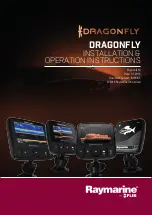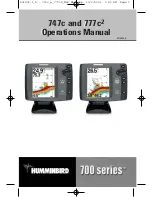
70
69
Pixels:
Pixels are the "picture elements", or small square blocks, that make up the
image on the LCD. Measured as a vertical by horizontal number (i.e. 640V x 320H),
this key specification typically indicates the quality of resolution. In fishfinders, the
total resolution (vertical multiplied by horizontal) is often less important than the
"Vertical Pixel" resolution. See
Pixels, Vertical
.
Pixels, Vertical:
Vertical Pixels are a number of vertical picture elements in a single
column on an LCD display. More vertical pixels provide finer resolution of targets
detected by sonar. Essentially, a vertical distance (the depth), when divided by a
larger number, breaks that distance into smaller samples, each representing a
smaller area and thus providing more detail. In fishfinders, vertical pixels are more
critical than horizontal pixels because the horizontal axis of the display represents
time, or history. Sonar information on the horizontal axis can vary greatly,
depending on boat speed and the Chart Speed setting. A greater number of
horizontal pixels show more sonar history that the boat has passed through. On
many models, Humminbird® provides the most vertical pixels to provide a better
display resolution. See
Chart Speed
and
Pixels
.
Power Output:
Power output is the amount of sound energy emitted into the water
by the sonar transmitter. Power output is measured using either RMS (Root Mean
Square) or P-T-P (Peak-to-Peak) measurement systems. Either method is acceptable,
but it is important, when comparing power outputs, to make sure that the same
measurement system is being used for both outputs, because P-T-P numbers are 8
times higher than RMS numbers. Greater power output allows the sonar signal to
penetrate through weeds and thermoclines, reach deeper depths and operate more
effectively in noisy environments, such as when the boat is running at high speed.
Pulse Width (Pulse Length):
Pulse Width is the length of time that a sonar sound
burst is transmitted into the water. Shorter pulse widths provide better target
separation, but cannot travel to great depths. Longer pulse widths provide better
depth penetration, but result in poorer target separation. Humminbird® varies pulse
width based on depth to optimize both target separation and depth performance.
See
Target Separation
.
QuadraBeam™:
QuadraBeam™ is a Humminbird® sonar configuration that uses four
sonar beams for a more detailed bottom image. QuadraBeam™ uses the DualBeam
PLUS™ configuration for downlooking, and also adds two additional beams to look
to the left and right. The sonar beams pointing to the left and right provide the
ability to spot fish and structure over a wide 90° area, and to identify on which side
of the boat they are located. See
DualBeam PLUS™
.
Quick Disconnect Mount:
The Quick Disconnect Mounting system is an exclusive
Humminbird® feature that permits the unit to be easily removed from the mounting
base by pressing a release button, and re-installed by simply snapping it back into
place. All cable connections are made when installing, so that no separate wiring
connections are required. Additionally, the mount offers 90° tilt and 360° swivel
capability to adjust the viewing angle of the unit as you move about the boat.
Real Time Sonar:
Real Time Sonar is a Humminbird® technology that delivers ultra-
fast sonar transmitter/receiver operation and results in a more detailed
instantaneous view of what is under the boat. The Real Time Sonar window is a
vertical band at the right side of the display that shows the instantaneous sonar
return from the transducer at a particular instant. The RTS® Window menu option
permits the user to adjust the window to show the full sonar signal return, or just a
narrower band that indicates intensity using grayscale. Real Time Sonar relies on
very fast Sonar Update Rate (Ping Speed). See
Sonar Update Rate
.
Receiver:
See
Transmitter
.
Second Return:
The Second Return is a term that describes the appearance of a
second sonar return below the primary sonar return (bottom contour) at exactly
twice the true depth. The second return is caused by the same sonar energy
bouncing off the bottom once, rebounding to the water surface and then traveling
back down to the bottom to be reflected again. Second returns are more common in
shallow water and over hard bottoms; it is actually possible to see a third sonar
return under some circumstances. The second return provides useful information to
help determine bottom hardness, as areas with harder bottoms will generally create
a second return. The second return can be used as a guide to set Sensitivity when in
shallower water.
Sensitivity:
Sensitivity is a user feature that adjusts the sensitivity of the sonar
system to show more or less detail in the water. Higher sensitivities are often
preferred; however, when the water contains debris (silt, storm debris, etc.) it can be
difficult to pick out targets. Conversely, if sensitivity is set too low, relevant targets
may be missed.
531474-1_A_777c2_English.qxd 11/3/2005 8:02 PM Page 76





















